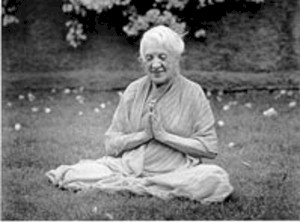Goldberg, Michelle. The Goddess Pose: The Audacious Life of Indra Devi, the Woman Who Helped Bring Yoga to the West, Alfred A. Knopf, New York, 2015 (322pp.$26.95)
Now that yoga is the province of slick promotions, self-indulgence, and the sweat-box mentality of exercise studios, it is hard to conceive of its beginnings in the rejection of ego and the acceptance of disappointment and suffering as the essence of life. As a system of physical fitness, yoga is a modern phenomenon. Indians, however, have been doing yoga for millennia, if by yoga is meant a plethora of distinct practices described by the great scholar of world religion Marcia Eliade as any “ascetic technique and any method of meditation.” Indeed, Indian yogis were the original metaphysical hucksters, traveling spiritualists who turned a buck and cadged a meal by twisting themselves into pretzels and by walking on fire. Now days, cute California chicks in spandex spend fifty bucks an hour sweating it out to James Taylor. Between these two yoga worlds lived a woman named Eugenia Peterson, whose fascinating life, eccentricities, and convoluted business ventures are the subjects of “The Goddess Pose”.
Michelle Goldberg is a journalist and the author of “Kingdom Coming: The Rise of Christian Nationalism”, as well as being senior contributing writer at The Nation magazine. Her story of Eugenia Peterson, born in 1899 in St. Petersburg, is an historical caravan of delectable adventure, written in a breezy yet convincing voice. For one thing, the woman who turned herself into a successful theosophist, teacher, writer, wandering mendicant and holy merchant (and became Indra Devi) led a life that tracks with the most significant events in the twentieth century. She and her mother survived the Russian Revolution and fled to Berlin, where Eugenia became a noted dancer and cabaret performer. When Berlin became Nazi, they fled to Shanghai and cobbled together a living teaching and performing. Along the way, Eugenia became fascinated with Indian mysticism, just then enjoying a sort of Western revival through the work of theosophists and hatha revivalists like Krishnamacharya and the yoga evangelist and practitioner Iyengar. Once Eugenia conceived her desire to go to India, it became an obsession.
By August 1932, Eugenia was on Bombay’s Chowpatty Beach after attending a festival in the city of Nasik. A German girlfriend convinced her to go see the sadhus. Together they wandered through the “rows of mushroom-like umbrellas stuck in the ground” where the sadhus were all naked, smeared with holy ash, some bent into impossible contortions. They resembled jugglers and acrobats in gray tights. Most had fantastic coiffures on their heads, towering up and up like birds’ nests. Like so many kindred spiritualists, Eugenia “spirited” for Hollywood, where she ultimately became Indra Devi and gathered about her celebrities like Gloria Swanson and Yehudi Menuhin. In Los Angeles in 1947, Eugenia was nearly broke, alone and homeless. A few years later, she emerged a full-fledged teacher with students like Jennifer Jones, pursuing the elusive spiritual awakening promised originally by Vivekananda’s Vedanta Center.
Living to the age of 103, this remarkable woman visited Russia during the height of the Cold War to spread the word, consulted with a Panamanian Colonel tied to strongman Noriega, and penned a number of “spiritualist” best sellers in the 1950’s. She lived at the end in Buenos Aires, visited Sri Lanka, and sold her message to denizens of the Hollywood Hills. It was an altogether astounding piece of esoteric vaudeville, cobbled together from the dribbles and back-splashes of Pantanjali’s “Yoga Sutra” written two thousand years ago in Sanskrit. Though she had at least one major unrequited love affair, she proceeded with neither the help nor hindrance of men. It was a bravura performance by a bravura individual.
For those interested in the spiritual ins and outs of Western “seeking”, “The Goddess Pose” is a breezy and very entertaining book.


